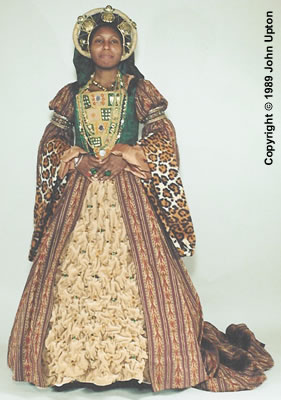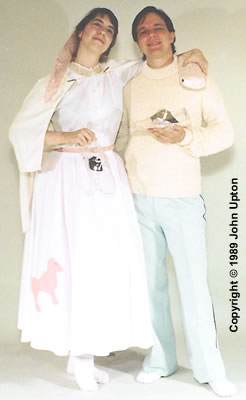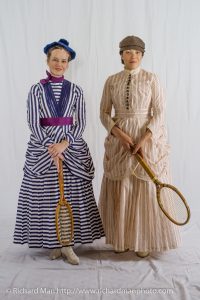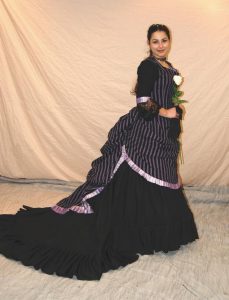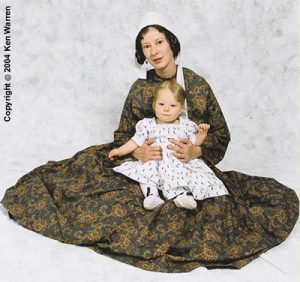CC07-H-02: Cinderella Goes to the Sock Hop (USA, 1950's)
CC07-H-02: Cinderella Goes to the Sock Hop (USA, 1950's) | Division: Journeyman | Category: Hist. Interpretation | Designer(s): Thomas Atkinson and Nea Dodson | Maker(s): Thomas Atkinson and Nea Dodson, Shoes by Chuck Coates | Presenter(s): Thomas Atkinson and Nea Dodson | Workmanship Award(s): Best Workmanship -- Shoes (Photo ID: John Upton 89-N14-27A | Event Date: 1989)
Competition Staff & Rules
Historical Masquerade Rules and Divisions
Historical Reproduction Masquerade Staff:
- Masquerades: Marty Gear‡
- Master of Ceremonies: Ricky Dick
- Presentation Judges: Adrian Butterfield‡, Bobby Gear‡, Caroline Kayta Martz‡
Rules:
THE MASQUERADES
As is traditional, there will be two Masquerades at Costume Con Seven; the Fantasy & Science Fiction Masquerade on Saturday Night, and the Historical Masquerade on Sunday Night. The rules for these Masquerades are as follows:
GENERAL RULES (APPLICABLE TO BOTH MASQUERADES)
1. Originality: These Masquerades are intended for original work only. Purchased or rented costumes are not eligible to compete Such costumes will be detected and will be disqualified.
2. Time Limits: Entries with 1 to 4 individuals will be limited to a maximum of 60 seconds on stage. Entries with 5 or more individuals will be limited to 90 seconds. You must convince the Masquerade Director before the start of the convention that you need and deserve more time.
3. Introductions: We will have the facilities to play standard cassette tapes with music and/or introductions. Our M.C.’s will also be happy to read your introductions provided that they are clearly typed or printed There will be NO LIVE MICROPHONES for the contestants’ use! Contestants attempting to speak directly to the audience will be disqualified.
4. The Junior Division, as a group, will appear first.
5. If necessary, the staff reserves the right to change the order of appearance of any entrant.
6. If you are a part of a group costume, only one member of the group should register for the entire group, and the group will be given a single entrant number. We will, however, require the names and signatures of all members of the group. A group costume will compete at the Division level of the highest ranked member who constructed and/or designed the costume and will be judged as a group in that Division. (Remember that a group costume is only as good as its weakest costume.)
7. The weapons policy of the con will be strictly adhered to. Weapons that are a part of the costume may be displayed only on stage and only m a safe manner. Sharp points and cutting edges must remain safely covered except from the time immediately before going onstage until immediately after leaving the stage. No functional projectile weapon may be placed in firing condition or aimed at any person at any time, on stage or off! Due to local fire and safety regulations, no open flame, working laser, or flash paper/powder may be used. Sealed flash bulbs and electronic flash units may be used, but only with the prior approval of the Masquerade Director or his delegate. NO EXCEPTIONS WILL BE MADE!
8. Nudity. If you feel that nudity is essential to your costume, please limit it to the Masquerade auditorium, the Green Room, and the Rear Atrium of the hotel, and keep it covered in all other areas.
9. NO FLASH PICTURES WILL BE PERMITTED DURING THE MASQUERADE COMPETITION! We will have a photo area set aside where photographers can take flash pictures to their hearts’ content. Contestants will make the photographers very happy if they arrive early and stay late enough for the photographers to get pictures of them in their costumes.
10. Each contestant may appear only once in each competition.
11. The backstage staff will have full authority to eliminate anyone from the competition on the basis of taste, danger to the audience or other contestants, or for any other reason deemed sufficient You must be able to enter and leave the stage without help in order to appear. We will have people available to steady you, but not to lift or completely support you.
HISTORICAL MASQUERADE RULES
The Divisions for the Historical Masquerade Competition are somewhat different from those of the Fantasy & Science Fiction Masquerade, but serve the same purpose, i.e. they protect the first timer from having to compete with the experienced costumer. The Divisions for this competition are:
NOVICE: A contestant with no previous award in any historic costume competition; a first entry in an historic competition with some experience in another field of costuming or a first entry in any costume competition.
JOURNEYMAN: A contestant who has won a major award at a previous Costume Con Historical Masquerade but fewer than four such awards; an historic costumer with no professional experience and fewer than four major awards in any historic costume competitions; an experienced costumer who has won major awards in other fields of costuming but with little or no experience in historical costuming.
MASTER: A contestant who has won ‘Best in Show’ in an Historical Masquerade at a previous Costume Con; a contestant who has won four or more major awards in any historic costume competitions; a costuming professional who earns a significant portion of his/her income making or designing historic costumes.
Again, contestants may, at their discretion, compete in a higher Division than the one in which they are placed according to the above definitions, but may not compete in a lower Division.
The Historic Costume Competition will be further divided into Reproduction and Interpretation costumes, although there will be a single set of judges, and both groups will be intermixed during the presentations. Contestants from either group are eligible for ‘Best in Show’, but otherwise will not be in competition with each other.
HISTORICAL REPRODUCTIONS
These are garments which are carefully researched, documented, patterned sewn, and presented in a manner appropriate to the period. Authenticity and accuracy to the source will be the key elements of good Historic Reproduction costumes. Complete documentation is most important in this category as you will be judged against your documentation. If you are costuming ‘from the skin out’, this is the category for it. Note: while a movie costume may in itself be a kind of ‘interpretation’, your reproduction of said movie costume would be properly entered in the Reproduction category. Similarly, a costume such as Kathy Sanders’ ‘Rape of the Lock’ would properly be entered in the Reproduction category and would be judged against its source.
HISTORICAL INTERPRETATION
These are imaginative spin-offs based upon historic garments or an historic premise. In the past, they have included a wild-west scenario, living art-nouveau posters, Marie Antoinette as a ‘motorcycle slut’, and a ‘Musketeer from Mars.’ The stronger the historic basis the better the interpretation, but creativity is perhaps more important than authenticity in this category. To quote Alison Dayne Frankel, ‘Interpretation — The creation of a garment that reflects and deliberately re-works major design elements from one or more historical periods.’
JUDGING CRITERIA
DOCUMENTATION: All Documentation must be turned in to the Masquerade Director by BY 8:00 PM FRIDAY! If you will not be arriving at the con until after this cutoff, a copy of your documentation must be sent to the convention so that it is available for the judges by Friday evening. The judges have (committed themselves) to reading all documentation thoroughly before the Historical Masquerade, even if it means their forgoing much of the rest of the convention. They’re playing fair with you; please play fair with them by having your documentation in their hands on time.
Documentation will be judged as follows:
0 — No documentation or obviously inaccurate
1 — Minimum information listing time, place, and pattern source
2 — Same as 1 with photocopies of drawings but no additional detail
3 — Same as 1 with additional detail including, at the least specific examples, primary sources if available, and rationale for fabric, color, and design of major elements of garment and construction
4 – Same as 3 plus rationale for all elements of the costume including the minor details; a display of understanding of general style of the period represented; explanation of any deviations from the period norm
AUTHENTICITY: This will be judged to the degree the entrant wishes, Reproductions of clothing striving for accuracy will be carefully examined in a prejudging session before the masquerade so that details of garments which may be lost on stage will receive recognition. On the same note, interpretive categories need not be judged ‘from the skin out’.
Judging for Authenticity will be as follows:
0 – Blatantly modern
1 — Period elements incorrectly combined (i.e. inappropriate mix of time and culture. This would not apply to movie costumes or others such as “Rape of the Lock”)
2 — Looks authentic on the surface, but has unauthentic elements in design, color, fabric, etc. (“Theater costume” — fake underlayers)
3 — Authentic in look and feel; attempt made to reproduce the ‘hand’ of original fabrics and imitate period techniques
4 — Above plus a special effort to achieve total period effect; embellishment, accessories made by the entrant, presented with movement and manners correct for the period.
CREATIVITY: A different type than that for the F&SF costumer comes into play in the Historical Masquerade. Rather than relying on a purely original premise, historical ‘creativity’ will be judged as follows:
0 — An exact copy from a modern source such as Folkwear Patterns
1 — A standard style for the period, mostly copied from a familiar source such as The Evolution of Fashion
2 — Logical combination of period elements, taken from various sources
3 — Individual interpretation, logical to the period
4 — Innovative combination of elements, logical to a single period; looks as if it was the work of a single creative historical designer.
WORKMANSHIP: Quality is quality no matter what the category, and a beautiful job deserves recognition. The elements of workmanship that the judges will be rating are:
Technical — Seam finishing, stitching, neatness
Fit — Does it hang correctly? Is the move and fit appropriate to the period and style?
Handling of Fabric — Choice of appropriate fabric, use of nap, print, bias, etc.
Construction Details — Interfacing, smocking, pleating details, linings, etc., as appropriate
COMPLEXITY: This applies to the scope of the project attempted rather than to the workmanship. The elements of complexity are:
Scope of the Project — Number of pieces, size in relation to detail, etc.
Variety of Techniques used — (as appropriate to the costume)
Difficulty of the techniques attempted
Extent of original pattern work done by the contestant
OVERALL OBSERVATION: How well do the separate elements work together?
BONUS POINTS: After the judges have scored the contestants in the above areas, bonus points may be awarded for such things as hand sewing, truly authentic fabrics etc. Bonus points will not ‘save’ a mediocre costume, but may serve as a ‘tie breaker’ between two truly outstanding costumes.
If you have questions, or require clarification of any of these rules, please see the Masquerade Director, Marty Gear‡ (ask at the Masquerade Registration Desk).
